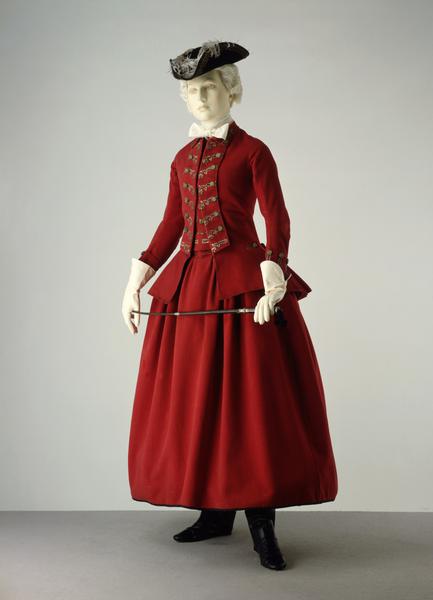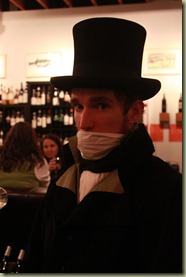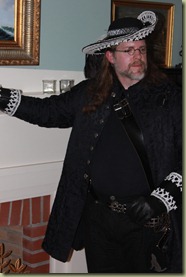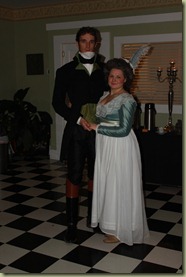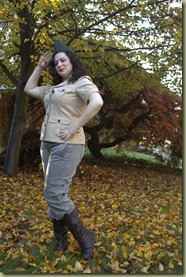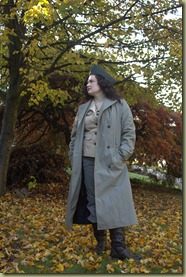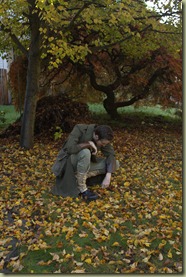I am officially a housewife!!!!!! More costumey posts will follow, I promise. Now, I must adjust to new schedule, yeah!!!!
Tuesday, November 30, 2010
Thursday, November 25, 2010
Mrs. Cartwright’s Jacket: Part 1
I finally had a chance to take some pictures of the jacket I am working on for Mrs. Cartwright. Enjoy!
The inspiration… A Zone Front Jacket from the Kyoto Costume Institute.
The fabric, a navy silk velvet, and the trim, gold fringe. I will need to trim the trim a bit, it is too long.
Drafting the Pattern. I used her Riding Habit bodice and JP Ryan Robe l’Anglaise bodice as a guide.
The first mock up on the form. The dress form does not give it the right look, but it allows me to get an approximation of her measurements. It’s at the fittings that I do most of the adjustments. Also, the bodice will lay smooth on the wearer, without the folds caused by the dress form.
I put the mockup on the form with the seams on the outside. It looks really goofy, but it allows me to make adjustments. The peplum will be pleated and there is not a waist seam.
I will keep posting the progress. Have a lovely Thanksgiving!
Love Lauren
Created By Lauren at 11:50 AM Witty Sentiments (4)
Friday, November 19, 2010
Inspiration...
Created By Lauren at 12:41 PM Witty Sentiments (5)
Tuesday, November 16, 2010
Ladies Riding and Walking Boots...
Created By Lauren at 11:30 AM Witty Sentiments (15)
Monday, November 15, 2010
Villian’s Ball
Sir Thomas and I attended a small gathering at the Ainsworth Estate on Saturday Eve. We joined the de Valois’ and Mme de Bordeaux for libations at a local tavern before arriving at the estate. The evening was quiet and we spent the time laying whist and drinking fine wines and ports at the card tables. It was a relaxing evening full of diverting conversation and company.
Sir Thomas
Me
Colonel de Valois
Mme de Valois and Me
Us
Created By Lauren at 8:48 PM Witty Sentiments (5)
A Costume Rant, Focusing on the Late 18th Century and Women's Clothing...
It never ceases to amaze me how a few wrong fabric choices, ill- fitting undergarments, and poor tailoring can take what could be a beautiful garment and throw it into the Crimes Against Historical Clothing category, aka Farb. Now, I have a few monstrosities buried in the depths of my closet never again to see the light of day. Every costumer does, it's all part of the learning experiences, the building blocks for learning how to create beautiful clothing. So hopefully, you can learn from my mistakes with a few tricks I have picked up along the way... Enjoy!
 First and foremost, research, research, research. I cannot stress it enough. We are very blessed to have volumes of books written about historical clothing and how to recreate it accurately. Not to mention the scores of sites and blogs devoted to historical clothing and sewing techniques. We have the information right at our finger tips; use it and learn as much as you can from it. Also, ask questions, lots of questions. This is one thing that I still do with many of my projects. I seek out costumers who are more skilled and experienced and pick their brains. You will find that most people are more than happy to share what they have learned and know with you.
First and foremost, research, research, research. I cannot stress it enough. We are very blessed to have volumes of books written about historical clothing and how to recreate it accurately. Not to mention the scores of sites and blogs devoted to historical clothing and sewing techniques. We have the information right at our finger tips; use it and learn as much as you can from it. Also, ask questions, lots of questions. This is one thing that I still do with many of my projects. I seek out costumers who are more skilled and experienced and pick their brains. You will find that most people are more than happy to share what they have learned and know with you.  |
| 18th Century Cartoon Showing the Female Shape with Stays |
Secondly, no matter what era of clothing you wish to recreate, you must remember that the female body was viewed very differently from the way we view it today. They believed the female body needed extra support. As a result women wore stays, or corsets depending on what time period you focus on. Not only were they the building blocks of the female wardrobe, their shape also defined the shape for the garments worn on top of them. Now, my era, which tends to be around 1795, was a time of great transition. Political upheaval changed the rules for fashion and for the first time, the smooth conical shape of previous eras was replaced by the high waisted, freer styles of the Regency and Empire eras. Now, unless you were one of the Merveilleuses running around the Champs de'lysses wetting down your thin white muslin gown, you would have still worn some sort of stays (yes, they did this). Thankfully, however, the transitional period allows for a choice as to which stays you prefer. You have your traditional long stays of the 1780's, which were still fashionable until the late, late 1790's, the ever popular, and my personal favorite, transitional stays, the later styled long stays of the 1800's, and, for those of you who are willowy, the bodiced petticoat. Now, for those of us, like me, who have a bit of fluff, the bodiced petticoat just does not provide enough support for the erm... girls. Anyway, any of these choices will work to create the desired silhouette for the late 18th century, early 19th century time period. However, as with any type of clothing, your choice of desired shape should flatter your figure and play up your assets. Also, you must chose your undergarments based on the outer garment you wish to make. For example, you would never wear transitional stays under a Robe l'Anglais, the shape will not work without long stays. Just as you would not wear 1780's style long stays under an 1810 dress. Each style must have the proper foundations to have a correct shape and look.
 |
| Original Dress from 1795 |
 |
| Mantua Maker's Shop |
 Finally, the way you act, stand, speak, and carry yourself makes a huge difference in your overall appearance. Digging out your cell phone and talking about work at a historical event puts a damper on the willing suspension of disbelief. However, acting as one would have in the time period you are portraying not only creates a new dimension of realism, it's much more fun. What is the point of reenacting if you bring the modern world along, in my humble opinion.
Finally, the way you act, stand, speak, and carry yourself makes a huge difference in your overall appearance. Digging out your cell phone and talking about work at a historical event puts a damper on the willing suspension of disbelief. However, acting as one would have in the time period you are portraying not only creates a new dimension of realism, it's much more fun. What is the point of reenacting if you bring the modern world along, in my humble opinion.Created By Lauren at 1:03 PM Witty Sentiments (18)
Sunday, November 07, 2010
Halloween Piccs…. A Little Late
We went antiquing at the Expo for Halloween and we decided to don our Dieslepunk gear. Here are a few pics. Enjoy!
It was fun wearing military gear, but I think I’m ready to return to my civilian gharb ![]() Have a great week, everyone!
Have a great week, everyone!
Love Lauren
Created By Lauren at 7:16 PM Witty Sentiments (5)







+Angelica+Peale++and+Alexander+Robinson.+Reynolda+House,++Museum+of+Art,+Winston-Salem,+North+Carolina.+Reproduction+at+1st-art-gallery.com..jpg)






